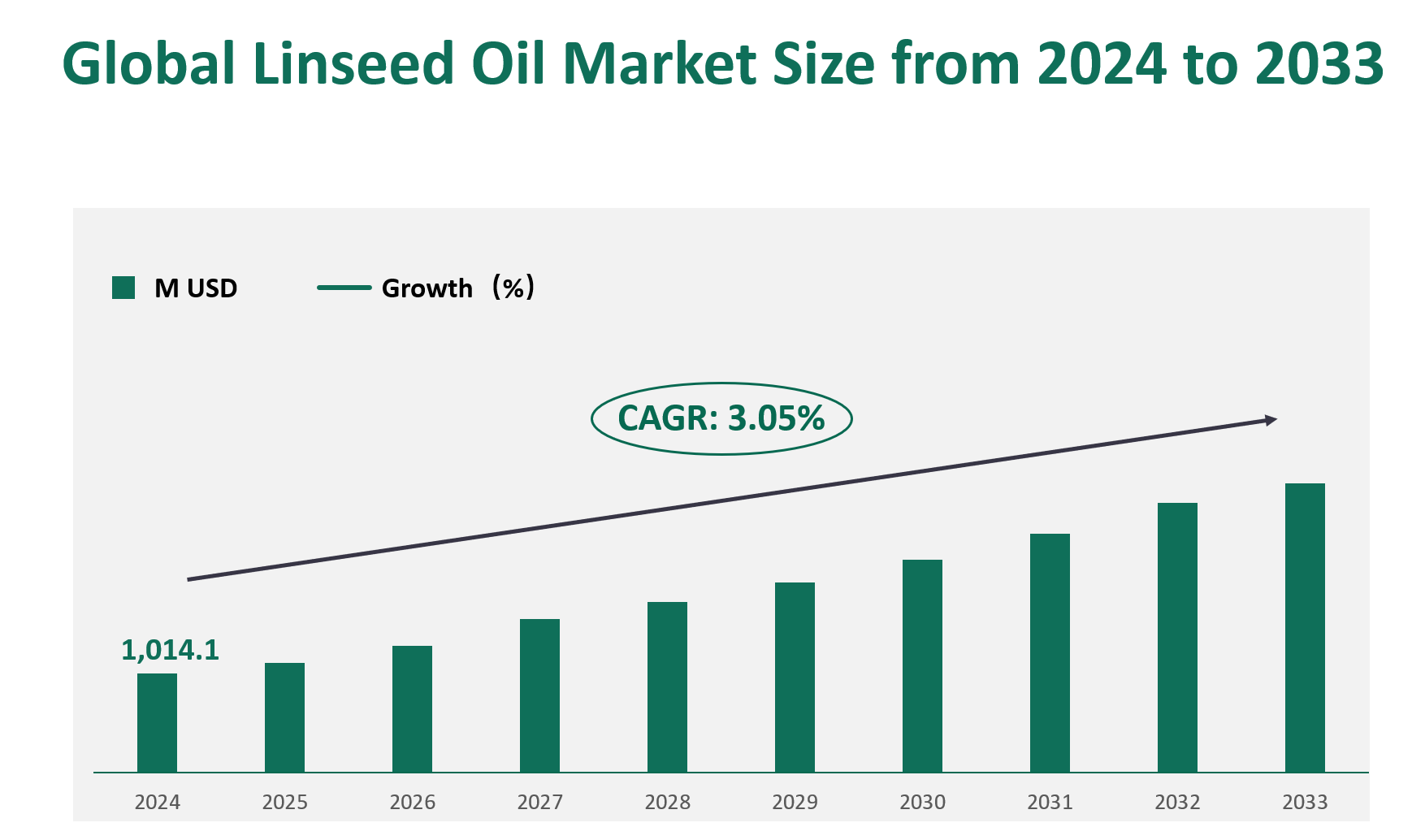1. Global Linseed Oil Market Insight Analysis
The global Linseed Oil market is projected to reach a revenue of 1,014.1 million (USD) in 2024, with a steady Compound Annual Growth Rate (CAGR) of 3.05% from 2024 to 2033.
Linseed Oil, also known as flaxseed oil, is a versatile product derived from the dried and ripened seeds of the flax plant. It is obtained through pressing, sometimes followed by solvent extraction. This oil has a wide range of applications, including edible uses such as cooking oil and health supplements, as well as non-edible applications like paints, varnishes, flooring, cosmetics, and pharmaceuticals. The market’s growth is expected to be sustained by increasing demand from these diverse sectors, particularly in regions with strong economic development and growing populations.
Linseed Oil is renowned for its rich nutritional profile, particularly its high content of Omega-3 fatty acids, which offer significant health benefits. These include improved heart health, reduced inflammation, and better blood sugar management. The oil’s versatility and health benefits have positioned it as a valuable commodity in both the food and industrial sectors. As the global economy continues to recover and grow, the demand is expected to rise, driven by increasing consumer awareness of health benefits and expanding industrial applications.
Figure Global Linseed Oil Market Size (M USD) and CAGR (2024-2033)

2. Driving and Limiting Factors of Linseed Oil Market Growth
The growth of the global Linseed Oil market is influenced by a combination of driving and limiting factors. On the positive side, the increasing awareness of health benefits associated with Omega-3 fatty acids is a significant driver. Consumers are becoming more health-conscious, and the demand for natural and nutritious food products is on the rise. This trend is particularly evident in developed countries and emerging economies, where the middle-class population is growing and disposable incomes are increasing. The cosmetic industry is also a major driver, as Linseed Oil is used in various skincare and haircare products due to its moisturizing and anti-inflammatory properties.
Another key driver is the expanding industrial applications. Its use in paints, varnishes, and flooring materials is well-established, and ongoing technological advancements are enhancing its performance in these areas. Additionally, the aging population is increasing the demand for health supplements, further boosting the market for edible oil.
However, the market also faces several limiting factors. One of the primary challenges is the intense competition within the industry. The market has a low entry barrier, leading to a large number of market participants. This has resulted in product homogeneity and price wars, which can erode profit margins. Additionally, the market is sensitive to fluctuations in the price of raw materials, particularly flaxseed. Adverse weather conditions or changes in agricultural practices can impact flaxseed production, leading to supply shortages and price volatility.
Another limiting factor is the presence of substitute products. For example, other sources of Omega-3 fatty acids, such as fish oil and chia seeds, compete with Linseed Oil in the health supplement market. In the industrial sector, synthetic alternatives to Linseed Oil are also available, which can affect market demand.
3. Technology Innovation and Corporate Mergers and Acquisitions in Linseed Oil Market
Technological innovation and corporate mergers and acquisitions (M&A) are playing crucial roles in shaping the Linseed Oil market. Technological advancements are enhancing the efficiency of oil production and improving its quality. For example, new pressing techniques and refining processes are increasing the yield and purity of the oil. Additionally, research and development efforts are focused on developing new applications, such as in biofuels and advanced materials. These innovations are not only expanding the market’s potential but also improving the product’s competitiveness in various sectors.
Corporate M&A activities are also driving market consolidation and growth. Major players are engaging in strategic acquisitions to expand their market share and diversify their product portfolios. For instance, Archer Daniels Midland Company (ADM) completed the acquisition of Neovia in 2019, significantly enhancing its position in the global market. Such acquisitions allow companies to leverage synergies, improve operational efficiency, and access new markets and customer bases.
Moreover, companies are investing in new manufacturing facilities and expanding their production capacities to meet growing demand. For example, Bioriginal Food & Science Corp. installed a new bottling line in 2020, enabling it to offer finished products and expand its capabilities in the European and Asian markets. These investments in infrastructure and technology are critical for companies to remain competitive and capitalize on market opportunities.
4. Global Linseed Oil Market Size by Type
Linseed oil is categorized into two primary types: edible and non-edible.
Edible oil is primarily used for culinary purposes and health supplements. It is rich in omega-3 fatty acids, which offer numerous health benefits, including improved heart health, reduced inflammation, and enhanced cognitive function. This type of oil is often used in cooking oils, salad dressings, and health capsules. The market revenue for edible oil in 2024 is projected to be 636.93 million USD.
Non-edible oil is used in various industrial applications, such as paints, varnishes, and wood treatments. It is valued for its drying properties and ability to protect and enhance the appearance of wood and other surfaces. This type of oil is also used in the production of linoleum, a type of flooring material. The market for non-edible oil is driven by the construction and furniture industries, where its unique properties make it an essential component. The non-edible linseed oil segment is expected to be 377.17 million USD.
Table Global Linseed Oil Market Size by Type in 2024
5. Global Linseed Oil Market Size by Application
Flaxseed oil has been used in the production of paints and varnishes for centuries due to its excellent drying properties and ability to form a durable, protective film. It is a key ingredient in oil-based paints, varnishes, and wood finishes, providing a natural and environmentally friendly alternative to synthetic products. The market revenue for paints and varnishes is expected to reach $180.19 million (USD) in 2024
Flaxseed oil is used in the production of floor finishes and sealants, particularly for wooden floors. It provides a natural, non-toxic alternative to synthetic floor finishes, offering excellent protection and a beautiful finish. Linseed Oil-based floor products are known for their ability to enhance the natural beauty of wood while providing long-lasting protection. The market revenue for flooring applications is projected to be $72.30 million (USD) in 2024.
Flaxseed oil is used in the cosmetic industry due to its rich content of Omega-3 fatty acids and other beneficial nutrients. It is used in skincare products such as moisturizers, serums, and facial oils, as well as in haircare products like shampoos, conditioners, and hair oils. Linseed Oil helps to moisturize and nourish the skin and hair, providing a natural and effective solution for various skin and hair conditions. The market revenue for cosmetics is expected to reach $169.94 million (USD) in 2024.
Flaxseed oil is used in the pharmaceutical industry as a source of Omega-3 fatty acids, which are known for their health benefits. It is used in the production of dietary supplements, capsules, and other pharmaceutical products that aim to provide health benefits such as improved cardiovascular health and reduced inflammation. The market revenue for pharmaceutical applications is projected to be $18.93 million (USD) in 2024.
Table Global Linseed Oil Market Size by Application in 2024
Application | Market Size (M USD) 2024 | Market Share |
Paints & Varnishes | 180.19 | 17.77% |
Flooring | 72.30 | 7.13% |
Processed Food | 562.45 | 55.46% |
Cosmetics | 169.94 | 16.76% |
Pharmaceuticals | 18.93 | 1.87% |
Others | 10.30 | 1.02% |
6. Global Linseed Oil Market by Top Regions
China is anticipated to dominate the global Linseed Oil market in terms of revenue, with an estimated market share of around 34.95% in 2024. This dominance can be attributed to several factors. China has a large agricultural base, which facilitates the production of flaxseed, the primary raw material for flaxseed oil.
Europe is expected to hold the second-largest market share, with a revenue contribution of approximately 21.71% in 2024. The region’s strong presence in the cosmetics and pharmaceutical industries drives demand for flaxseed oil. European consumers are known for their preference for natural and organic products, which aligns well with the health benefits of flaxseed oil.
USA is projected to have a market share of around 14.47% in 2024. The region’s growing awareness of the health benefits of Omega-3 fatty acids has increased the demand for flaxseed oil in the food and dietary supplement sectors.
Figure Global Linseed Oil Market Size by Region in 2024

7. Global Linseed Oil Market Analysis by Major Players
7.1 Archer Daniels Midland Company (ADM)
Company Introduction and Business Overview: Archer Daniels Midland Company, founded in 1902, is a leading global agricultural producer, processor, and manufacturer. Headquartered in the United States, ADM is known for its extensive product portfolio, which includes more than 270 crop-processing products. The company operates in various sectors, including food, beverage, nutraceuticals, industrial, and livestock feed applications.
Products Offered: ADM offers a wide range of Linseed Oil products, including Onavita™ Flaxseed Oil, which is non-GMO and suitable for vegetarians and vegans. The company also produces various grades of Linseed Oil for industrial applications, such as paints, varnishes, and coatings.
Sales Revenue in 2022: ADM’s Linseed Oil sales revenue in 2022 was approximately $12.48 million (USD).
7.2 Hongjingyuan
Company Introduction and Business Overview: Hongjingyuan, established in 1983, is a large-scale modern private enterprise based in China. It is a leading producer of Linseed Oil and is known for its high-quality products. The company is the drafting unit of China’s national standard for Linseed Oil and has won several awards for its products.
Products Offered: Hongjingyuan offers primary pressed first-grade Linseed Oil, which is known for its high content of alpha-linolenic acid (50%-70%) and a shelf life of eighteen months. The company also produces various health supplements and food products using flaxseed oil.
Sales Revenue in 2022: Hongjingyuan’s Linseed Oil sales revenue in 2022 was approximately $22.61 million (USD).
7.3 Datong Huajian
Company Introduction and Business Overview: Datong Huajian, established in 1996, is a production-oriented enterprise based in China. The company focuses on the research and development and production of flaxseed oil and is one of the largest manufacturers in the country.
Products Offered: Datong Huajian offers cold-pressed Linseed Oil, which is known for its high quality and purity. The company also produces various Linseed Oil-based products for industrial applications.
Sales Revenue in 2022: Datong Huajian’s Linseed Oil sales revenue in 2022 was approximately $10.85 million (USD).

